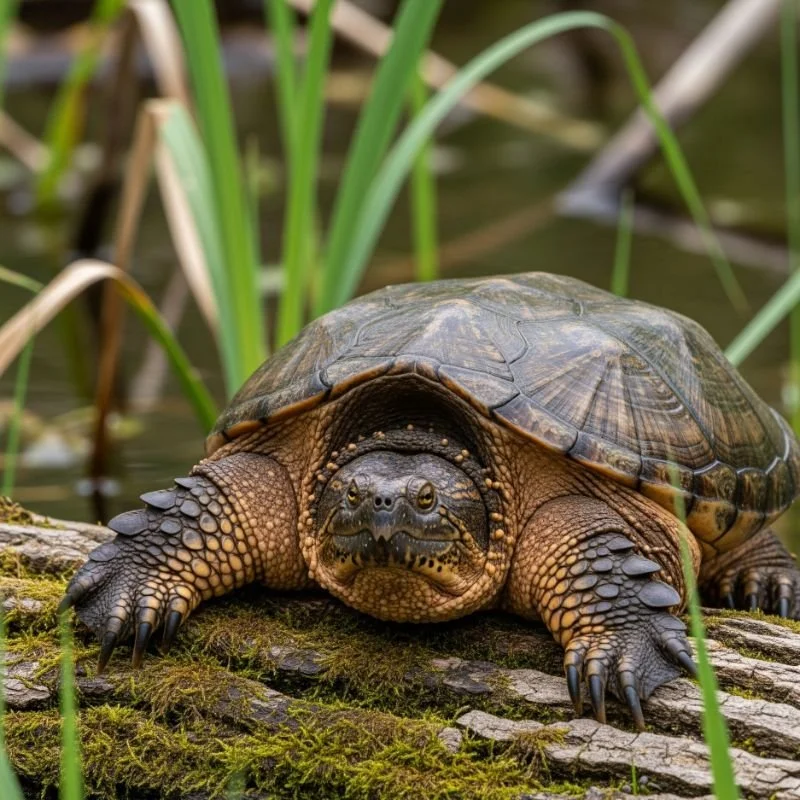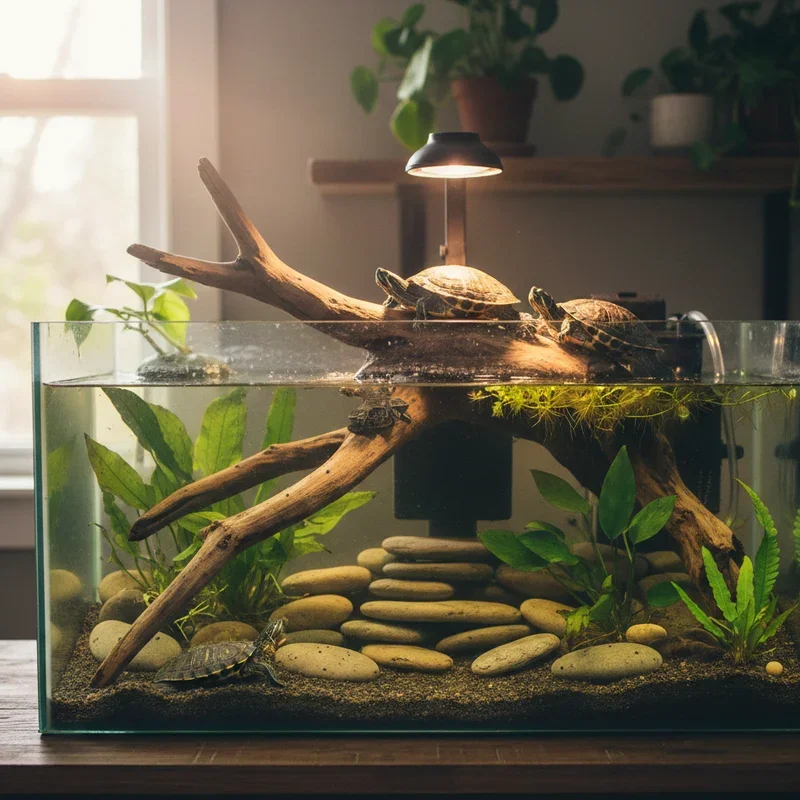What Do Snapping Turtles Eat in the Wild and at Home
Discover what snapping turtles eat in wild habitats and captivity. Learn about their diverse diet, feeding habits, and nutritional needs in this guide.
Ever wondered what's on the menu for those prehistoric-looking creatures lurking in ponds and rivers? Well, you're in for a treat! Snapping turtles, those grumpy-faced reptiles with jaws that could make a crocodile jealous, have quite the appetite. Whether they're cruising through murky waters in the wild or chilling in a backyard pond, these shelled warriors aren't picky eaters. In fact, understanding what snapping turtles eat in the wild and at home can help us appreciate these fascinating creatures better, and if you're brave enough to keep one as a pet, it'll help you keep your snapper happy and healthy.
What Makes Snapping Turtles Such Voracious Eaters?
Let's face it, snapping turtles didn't get their fearsome reputation by nibbling on lettuce leaves! These opportunistic feeders have been around for millions of years, and boy, have they perfected the art of eating just about anything that fits in their mouths. Their powerful jaws, which can deliver a bone-crushing bite, aren't just for show. They're essential tools that help them tackle a variety of prey, from slippery fish to tough-shelled mollusks.
What's really cool about these creatures is their adaptability. Living in various aquatic environments, from slow-moving rivers to marshy wetlands, snappers have learned to make the most of whatever food sources are available. This flexibility in their diet has helped them survive when other species have gone the way of the dodo.
What Do Snapping Turtles Eat in the Wild?
The Aquatic Buffet
In their natural habitat, snapping turtles are like the garbage disposals of the aquatic world, and I mean that in the best way possible! They play a crucial role in maintaining ecological balance by consuming:
Fish of all sizes (from tiny minnows to decent-sized bass)
Aquatic invertebrates (crayfish, water beetles, dragonfly larvae)
Amphibians (frogs, salamanders, and their tadpoles)
Small mammals (muskrats, mice that venture too close to water)
Water birds (ducklings, goslings, and occasionally adult birds)
Carrion (dead animals that sink to the bottom)
Aquatic vegetation (algae, duckweed, water lilies)
Hunting Strategies That'll Make Your Jaw Drop
Snapping turtles have developed some pretty clever hunting techniques over the millennia. The common snapper often employs the "sit and wait" strategy, burying itself in mud or sand with only its eyes and nostrils visible. When an unsuspecting victim swims by, SNAP! Dinner is served.
Alligator snapping turtles, on the other hand, have taken deception to a whole new level. They've got this pink, worm-like appendage on their tongues that they wiggle to attract fish. Talk about fishing with built-in bait!
Seasonal Dining Preferences
Just like how we might crave hearty stews in winter and fresh salads in summer, snapping turtles adjust their diet based on the season:
Spring: After emerging from hibernation, snappers are ravenous. They'll actively hunt for protein-rich foods like fish, amphibians, and invertebrates to replenish their energy reserves.
Summer: This is prime feeding time! With abundant food sources, turtles feast on everything from aquatic plants to small mammals. Young water birds are particularly vulnerable during this season.
Fall: As temperatures drop, snappers start bulking up for winter. They'll consume larger quantities of food and may become more aggressive hunters.
Winter: In colder regions, snappers enter a state of brumation (similar to hibernation) and barely eat. In warmer climates, they remain somewhat active but eat significantly less.
Home Sweet Home: Feeding Snapping Turtles in Captivity
Setting Up the Perfect Dining Experience
Keeping a snapping turtle as a pet? Well, aren't you brave! Creating a proper feeding environment is crucial for your shelled friend's health and happiness. Here's what you need to know:
First off, feeding should always happen in the water. Snappers need water to swallow their food properly, so dry feeding is a no-go. Many keepers use a separate feeding tank to keep the main habitat cleaner, which is a smart move considering how messy these guys can be when they eat.
What Do Snapping Turtles Eat in the Wild and at Home: The Captive Menu
While wild snappers enjoy a varied diet, captive turtles need a carefully balanced menu to stay healthy:
Protein Sources (70-80% of diet for juveniles, 50-60% for adults):
Feeder fish (goldfish, minnows, guppies)
Earthworms and nightcrawlers
Crickets and mealworms
Frozen-thawed pinkie mice (occasional treat)
Commercial turtle pellets
Raw chicken or turkey (boneless)
Shrimp and other seafood
Plant Matter (20-30% for juveniles, 40-50% for adults):
Leafy greens (romaine lettuce, dandelion greens, collard greens)
Aquatic plants (duckweed, water hyacinth, hornwort)
Vegetables (squash, sweet potato, carrots)
Fruits (occasional treats like berries, melon, apple)
Feeding Frequency and Portion Control
Here's where things get tricky. Overfeeding is one of the biggest mistakes turtle keepers make. These guys will eat until they burst if you let them! Follow these guidelines:
Hatchlings (0-6 months): Feed daily, as much as they can eat in 15 minutes Juveniles (6 months-2 years): Feed every other day Sub-adults (2-4 years): Feed 2-3 times per week Adults (4+ years): Feed 1-2 times per week
Remember, a hungry turtle is a healthy turtle. If your snapper is always begging for food, that's actually a good sign!
Nutritional Requirements: Getting the Balance Right
Calcium and Vitamin D3: The Dynamic Duo
Just like us humans need our vitamins, snapping turtles require specific nutrients to thrive. Calcium and Vitamin D3 are absolutely crucial for shell and bone development. In the wild, they get these from eating whole prey (bones and all) and basking in natural sunlight.
In captivity, you'll need to supplement their diet. Dusting food with calcium powder or offering cuttlebone are great ways to ensure adequate calcium intake. For Vitamin D3, UVB lighting is essential if your turtle doesn't have access to natural sunlight.
The Protein Predicament
While snappers love their protein, too much can cause serious health issues like pyramiding (abnormal shell growth) and kidney problems. Young turtles need more protein for growth, but as they mature, gradually increase the plant matter in their diet.
Common Feeding Mistakes to Avoid
The Goldfish Trap
Sure, goldfish are convenient and snappers love 'em, but feeding nothing but goldfish is like eating nothing but fast food. Goldfish are high in fat and lack essential nutrients. They also contain thiaminase, which destroys vitamin B1. If you do feed goldfish, make them an occasional treat, not a staple.
The Iceberg Lettuce Letdown
Iceberg lettuce is basically crunchy water with zero nutritional value. Stick to nutrient-rich greens like romaine, dandelion, or collard greens instead.
Overfeeding: Love Handles Aren't Cute on Turtles
An obese turtle is an unhealthy turtle. Signs of overfeeding include:
Fat deposits around the legs
Inability to fully retract into the shell
Lethargy
Pyramiding
Special Dietary Considerations
Baby Snappers: Tiny Turtles, Big Appetites
Hatchling snapping turtles are adorable little eating machines. In the wild, they primarily feed on small invertebrates, insect larvae, and tiny fish. Their diet is almost entirely carnivorous during this stage.
In captivity, offer:
Bloodworms
Brine shrimp
Daphnia
Finely chopped earthworms
High-quality turtle pellets (soaked to soften)
Senior Snappers: Adjusting for Age
As snapping turtles age, their metabolism slows down. Older turtles need:
Less frequent feedings
More plant matter
Easily digestible proteins
Smaller portion sizes
The Environmental Impact of Feeding
Wild Caught vs. Captive Bred Food Sources
When possible, opt for captive-bred feeder animals. Wild-caught prey can introduce parasites and diseases to your turtle. Plus, it's more environmentally sustainable!
Creating a Natural Feeding Environment
Enrichment isn't just for mammals! Snappers benefit from hunting opportunities. Try:
Releasing live fish in their enclosure
Hiding food in different locations
Using feeding tongs to simulate prey movement
Growing aquatic plants for grazing
Health Issues Related to Diet
Metabolic Bone Disease (MBD)
This serious condition results from calcium deficiency and inadequate UVB exposure. Symptoms include:
Soft, deformed shell
Swollen eyes
Lethargy
Difficulty swimming
Prevention is key! Ensure proper calcium supplementation and UVB lighting.
Vitamin A Deficiency
Often caused by an all-meat diet lacking in vegetables. Signs include:
Swollen eyes
Respiratory infections
Poor appetite
Adding dark leafy greens and orange vegetables can prevent this issue.
Seasonal Feeding Adjustments in Captivity
Even indoor turtles can sense seasonal changes. Adjust feeding accordingly:
Spring/Summer: Increase feeding frequency and offer more variety Fall: Gradually reduce feeding frequency Winter: Significantly reduce feeding for turtles in cooler environments
Conclusion
Understanding what snapping turtles eat in the wild and at home helps us provide better care for these remarkable reptiles. Whether they're hunting in murky waters or waiting for dinner in a home aquarium, snappers need varied, balanced diets. Remember, a healthy snapper is one that gets appropriate portions of proteins and plants, proper supplementation, and feeding enrichment that mimics natural behaviors.
Read next: Are Turtles Amphibians? Facts You Should Know
Frequently Asked Questions
Q1: Can snapping turtles eat cat food?
A: Occasionally as treats, but it's too high in protein for regular feeding.
Q2: How long can snappers go without eating?
A: Healthy adults can survive several months without food during brumation.
Q3: Do snapping turtles need live prey?
A: No, but live prey provides enrichment and encourages natural hunting behaviors.
Q4: Can I feed my snapper human food?
A: Some foods like lean meats and vegetables are okay, avoid processed foods.
Q5: Why won't my snapping turtle eat vegetables?
A: Try different types, mix with favorite proteins, or wait until they're older.












